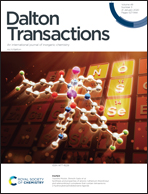Reduction-induced CO dissociation by a [Mn(bpy)(CO)4][SbF6] complex and its relevance in electrocatalytic CO2 reduction†
Abstract
[Mn(bpy)(CO)3Br] is recognized as a benchmark electrocatalyst for CO2 reduction to CO, with the doubly reduced [Mn(bpy)(CO)3]− proposed to be the active species in the catalytic mechanism. The reaction of this intermediate with CO2 and two protons is expected to produce the tetracarbonyl cation, [Mn(bpy)(CO)4]+, thereby closing the catalytic cycle. However, this species has not been experimentally observed. In this study, [Mn(bpy)(CO)4][SbF6] (1) was directly synthesized and found to be an efficient electrocatalyst for the reduction of CO2 to CO in the presence of H2O. Complex 1 was characterized using X-ray crystallography as well as IR and UV-Vis spectroscopy. The redox activity of 1 was determined using cyclic voltammetry and compared with that of benchmark manganese complexes, e.g., [Mn(bpy)(CO)3Br] (2) and [Mn(bpy)(CO)3(MeCN)][PF6] (3). Infrared spectroscopic analyses indicated that CO dissociation occurs after a single-electron reduction of complex 1, producing a [Mn(bpy)(CO)3(MeCN)]+ species. Complex 1 was experimentally verified as both a precatalyst and an on-cycle intermediate in homogeneous Mn-based electrocatalytic CO2 reduction.
![Graphical abstract: Reduction-induced CO dissociation by a [Mn(bpy)(CO)4][SbF6] complex and its relevance in electrocatalytic CO2 reduction](/en/Image/Get?imageInfo.ImageType=GA&imageInfo.ImageIdentifier.ManuscriptID=C9DT04150H&imageInfo.ImageIdentifier.Year=2020)


 Please wait while we load your content...
Please wait while we load your content...
